The Ti West Interview: Writing And Directing The House Of The Devil (2009's Best Horror Film), Nailing The '80s, And His "Shitty" Experience On Cabin Fever 2
When 2009 is reflected on later, it won't be the clunky, predictable Oscar-bait pics that standout but rather a new crop of outspoken auteurs that came into their own in '09 with stealthy, highly confident fare. A charged determination and can't-fail idealism is instilled in these directors that makes the filmmaking process once again exciting and truly daring: A young man's game. Writer/director, Ti West, is one such auteur. Not yet 30 years of age, West has crafted a horror film with an attention to detail, sex appeal, color and sound so as to evoke the paranoid trips of early Roman Polanski and the vintage, pop-darkly appreciation of early Richard Linklater and Paul Thomas Anderson.
Bearing a title that is epic and playfully dry, The House of the Devil reconnects the horror genre with roots-y, genuine, teetering suspense. By doing so, West also manages to grasp viewers in the claws of doom by way of a foreboding graveyard or a pitch black basement, as opposed to, say, a phallic torture chamber aired simultaneously on forty live surveillance cameras. Stylistically, West forwent mining homage from the Grindhouse well—so exhausted this decade—and instead made a film set in the '80s that not only looks period, but feels of it. The era's mundane pace of life and lack of social interconnection can be sensed from the movie's start and is incensed by the decade's "Satanic Panic": a media-exploited phenomenon that did for Satanism what coverage of the Zodiac Killer and Son of Sam did for serial killers in the '60s and '70s. At Devil's heart is the lead performance by newcomer, Jocelin Donahue, 27, who gets my vote for movie crush of 2009. Donahue plays Samantha, a smart, unsure college sophomore in dire need of a payday who eventually responds—in that '80s way—to a nondescript babysitter flyer. No one ever said that $atan doesn't have great taste.
From the way in which Donahue walks in high-waisted jeans to the way Samantha and her BFF eat and critique pizza, it's a luscious thrill to witness such a dope actress and director get it and get it some more. Moreover, West appears supported by one of the cooler, simpatico filmmaking crews working in indie films today. Unlike the stereotypical proto-auteur of past and present, West's horror movie shines as both the work of a driven perfectionist and a clear vision by a superlative collective; this enables the viewer to fall into, and fall in love with, all the creepy, masterful foreplay before West's plot rocks wildly alongside a devilish eclipse. Afterward, I desired to open a pack of THoTD trading cards showcasing the film's collaborators and characters alike rather than scan IMDB. Ti West discussed his creative process with /Film, as well as the film's titular House, its mystic pizza, and why his experience helming the yet-to-be-released Cabin Fever 2 was an effing nightmare straight outta Hell Hollywood.
Hunter Stephenson: Hi Ti. I found this to be a very uncompromising horror film. I think what many are finding to their surprise is that The House of the Devil is not an homage to the '80s a la Thanksgiving but a real period piece.Ti West: Thanks, I'm glad you see it like that because that's how I see it: as a period piece. I appreciate that. I mean, the film is basically about a cultural phenomenon in the 1980s, the Satanic Panic. So, I wanted to create a very accurate depiction of that and not do it tongue-in-cheek, or as a parody, because then people wouldn't care about the characters in the movie. That's why there's a really nice primer to the beginning of the film [explaining the Satanic Panic, complete with statistics], because so much of the film is a contrast between a lot of realism and then these very fantastic horror elements. And that's why, with the beginning, I wanted it to feel like this is something that could have really happened.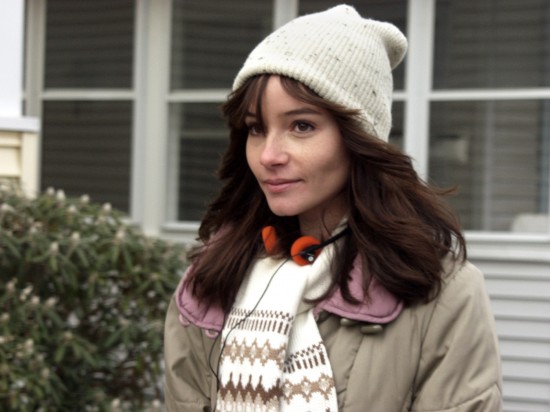 Let's talk about the involvement of Jocelin Donahue. You've said that this is the only cast member who you auditioned. Obviously, she has a great look that's perfect for the role, but what type of discussions did you two have per her performance?Ti West: She has a great look, obviously, and one that is very appropriate for the time. But she came in and I liked her reading and I liked her personality. We got along very well. And it's always important to me that people understand the movie we're making, and she got it. She got the subtle details, which a lot of others didn't understand. So, the fact that she got it and that I had to trust her to carry the entire movie on her shoulders—that's not easy—by the time we started filming she made me comfortable with allowing her to do her own thing.With the fashion in the movie, can we discuss this a bit? It's very easy to fall into hipstery Urban Outfitters mode with a film set in this era and with such attractive, knowing actresses. Who was in charge of the fashion selection on the film and what were those discussions like?Ti West: Well, Robin Fitzgerald is the costume designer and her and I have known each other for a while, and you know, I am very particular, I am very OCD about [the fashion in the movie]. So, I had very particular outfits in mind, and her and I would go to, like, Universal or Disney, and go to the costume shops. And we'd literally spend hours combing through looking for stuff. And then we would have Jocelin come over to the shops and try on some stuff, and it was a very collaborative effort. But I was really looking for, like, an exact kind of plaid shirt, and an exact kind of jeans and sneakers. And I think I drove Robin a bit crazy about how particular I was [laughs], but it was very important to me. And we did that for all the characters, really trying to make it so that it wasn't, "Oh, this is like 'Video Killed the Radio Star' '80s," and it's becoming a parody. I wanted it to be as real as possible...
Let's talk about the involvement of Jocelin Donahue. You've said that this is the only cast member who you auditioned. Obviously, she has a great look that's perfect for the role, but what type of discussions did you two have per her performance?Ti West: She has a great look, obviously, and one that is very appropriate for the time. But she came in and I liked her reading and I liked her personality. We got along very well. And it's always important to me that people understand the movie we're making, and she got it. She got the subtle details, which a lot of others didn't understand. So, the fact that she got it and that I had to trust her to carry the entire movie on her shoulders—that's not easy—by the time we started filming she made me comfortable with allowing her to do her own thing.With the fashion in the movie, can we discuss this a bit? It's very easy to fall into hipstery Urban Outfitters mode with a film set in this era and with such attractive, knowing actresses. Who was in charge of the fashion selection on the film and what were those discussions like?Ti West: Well, Robin Fitzgerald is the costume designer and her and I have known each other for a while, and you know, I am very particular, I am very OCD about [the fashion in the movie]. So, I had very particular outfits in mind, and her and I would go to, like, Universal or Disney, and go to the costume shops. And we'd literally spend hours combing through looking for stuff. And then we would have Jocelin come over to the shops and try on some stuff, and it was a very collaborative effort. But I was really looking for, like, an exact kind of plaid shirt, and an exact kind of jeans and sneakers. And I think I drove Robin a bit crazy about how particular I was [laughs], but it was very important to me. And we did that for all the characters, really trying to make it so that it wasn't, "Oh, this is like 'Video Killed the Radio Star' '80s," and it's becoming a parody. I wanted it to be as real as possible...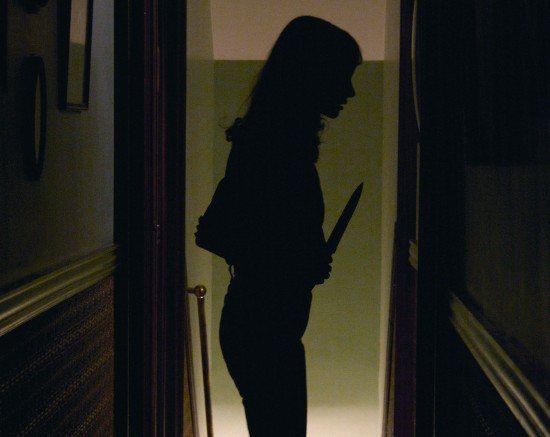 Cool. What's interesting, and easy to miss on the first viewing, is that Jocelin's character, Samantha, there's a dichotomy between her and her roommate, who sort of represents the '70s, a looser period, and Greta Gerwig's character, Samantha's best friend Megan. I feel like Megan represents, like, '80s entitlement. It feels like Samantha is caught in the middle of these two girls and yet doesn't belong...do you agree with any of that? [laughs]Ti West: Yeah. That was something that I really wanted: this is a character that feels really isolated in her own environment, because she didn't really fit in; and not because she was anti-social, or she was a geek or something. But what she's interested in in life, and the current climate of the people she was with, it didn't match up. And that, combined with her being broke—which was a very personal thing when I wrote it—it captured that time period when you get out of college and you're introduced to life, and you're not that into it, but you have to deal with it anyway...And you're trying to figure out your own path. And that's where the methodology between [Samantha's relationships] came from. Then again, that experience is something that Jocelin really understood when she came in, which made it easier.It's also nice, because you don't see a lot of characters in horror movies or any movies generally that are dealing with being broke. That pressure can be frightening out of university. And with the new Depression, perhaps it resonates more, a lot of kids are broke as hell right now...Ti West: Yeah. [laughs] It's funny, because I wrote this movie long before that, so when we finally made it, we realized that it was Recession-friendly; so people are going to think I'm commenting on that, but this was before all that happened. But I think that it does...these are feelings that everyone has at that age, and unfortunately they have become almost, like, repetitive trends that happen. So, yeah, maybe we've reached a period where more people can relate to it.
Cool. What's interesting, and easy to miss on the first viewing, is that Jocelin's character, Samantha, there's a dichotomy between her and her roommate, who sort of represents the '70s, a looser period, and Greta Gerwig's character, Samantha's best friend Megan. I feel like Megan represents, like, '80s entitlement. It feels like Samantha is caught in the middle of these two girls and yet doesn't belong...do you agree with any of that? [laughs]Ti West: Yeah. That was something that I really wanted: this is a character that feels really isolated in her own environment, because she didn't really fit in; and not because she was anti-social, or she was a geek or something. But what she's interested in in life, and the current climate of the people she was with, it didn't match up. And that, combined with her being broke—which was a very personal thing when I wrote it—it captured that time period when you get out of college and you're introduced to life, and you're not that into it, but you have to deal with it anyway...And you're trying to figure out your own path. And that's where the methodology between [Samantha's relationships] came from. Then again, that experience is something that Jocelin really understood when she came in, which made it easier.It's also nice, because you don't see a lot of characters in horror movies or any movies generally that are dealing with being broke. That pressure can be frightening out of university. And with the new Depression, perhaps it resonates more, a lot of kids are broke as hell right now...Ti West: Yeah. [laughs] It's funny, because I wrote this movie long before that, so when we finally made it, we realized that it was Recession-friendly; so people are going to think I'm commenting on that, but this was before all that happened. But I think that it does...these are feelings that everyone has at that age, and unfortunately they have become almost, like, repetitive trends that happen. So, yeah, maybe we've reached a period where more people can relate to it.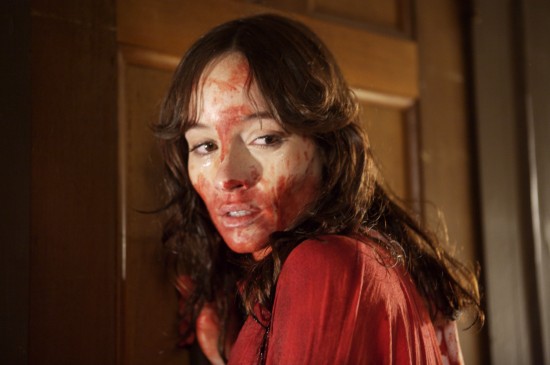 And Ti, I'm wondering with Dee Wallace's character as the Land Lady, which is a minor character at the beginning, what was her character's role in setting the tone? [Note: Wallace, in addition to a long career, played the separated mom in E.T.] I found that it was spooky how her character tells Samantha that she looks so much like her daughter. And that's one of several girls mentioned in Samantha's presence whom we never see. But with Dee Wallace's character, what role did she play in the film's tone?Ti West: Yeah, Dee's character to me, she represented what Sam was looking for, which was a potential way out. I've always had a fondness for Dee, and having her be the gatekeeper and having her be a sympathetic...she's a very all-business kind of land lady, but there's something sympathetic about her and something motherly that, like, reminded me...there was a comfort level in that. I think it just made the idea that Sam was going to move to that place more sensible. So, that's ultimately where that came from, giving Sam the outlet she was looking for. But as far as referencing other people, that's nothing too specific, just referencing the different types of people that are out there in the real world [as opposed to on a college campus], which are surrounding you, whether they are "on screen" or not.What I also like about Wallace's character and performance is that it subtly causes you to ponder whether Samantha has close family. We never know one way or the other. But it adds to that creeping sense of isolation. Was that a goal you wanted to express from the very start of the picture?Ti West: It really was. I wasn't so interested in back story necessarily, which is why there's not a tremendous amount of that in the film for anybody. But, um, the sense that...something that was very interesting to me was the sense of being isolated when you're not, in fact, isolated; when you actually live in the same room as someone and you have a best friend around and you're surrounded by people, but you don't feel a connection to them in any way. And that sort of frustration that comes out of that is something that I'm interested in and is reflected in the film.
And Ti, I'm wondering with Dee Wallace's character as the Land Lady, which is a minor character at the beginning, what was her character's role in setting the tone? [Note: Wallace, in addition to a long career, played the separated mom in E.T.] I found that it was spooky how her character tells Samantha that she looks so much like her daughter. And that's one of several girls mentioned in Samantha's presence whom we never see. But with Dee Wallace's character, what role did she play in the film's tone?Ti West: Yeah, Dee's character to me, she represented what Sam was looking for, which was a potential way out. I've always had a fondness for Dee, and having her be the gatekeeper and having her be a sympathetic...she's a very all-business kind of land lady, but there's something sympathetic about her and something motherly that, like, reminded me...there was a comfort level in that. I think it just made the idea that Sam was going to move to that place more sensible. So, that's ultimately where that came from, giving Sam the outlet she was looking for. But as far as referencing other people, that's nothing too specific, just referencing the different types of people that are out there in the real world [as opposed to on a college campus], which are surrounding you, whether they are "on screen" or not.What I also like about Wallace's character and performance is that it subtly causes you to ponder whether Samantha has close family. We never know one way or the other. But it adds to that creeping sense of isolation. Was that a goal you wanted to express from the very start of the picture?Ti West: It really was. I wasn't so interested in back story necessarily, which is why there's not a tremendous amount of that in the film for anybody. But, um, the sense that...something that was very interesting to me was the sense of being isolated when you're not, in fact, isolated; when you actually live in the same room as someone and you have a best friend around and you're surrounded by people, but you don't feel a connection to them in any way. And that sort of frustration that comes out of that is something that I'm interested in and is reflected in the film.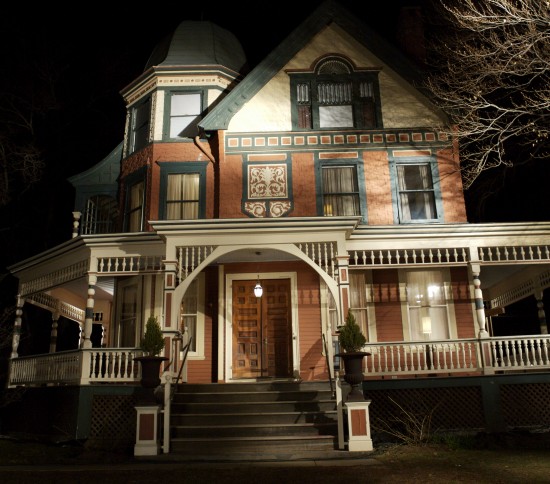 The film's House lives up to its title and is exquisitely presented. You almost allow it to reveal a bigger story through a type of voyeurism. Where was the House located, and how much work was done on the outside and inside? And were you inspired by house-horror like House II [note: the stained-glass window definitely reminded me of this film] and The Amityville Horror?Ti West: Well, the house is located in Connecticut and it's something we found simply by scouting. And it's actually, it's not very isolated at all, so I didn't want to use it at first. But we shot it from every angle to make it seem isolated, when in fact there were neighbors on all sides. And the outside pretty much looks like that, but the inside, however, looks absolutely nothing like it does in the movie, to an extreme. Like, you would never think it's the same place, and that's testament to how hard Jade Healy, our production designer, worked, because she completely transformed every room of the house.
The film's House lives up to its title and is exquisitely presented. You almost allow it to reveal a bigger story through a type of voyeurism. Where was the House located, and how much work was done on the outside and inside? And were you inspired by house-horror like House II [note: the stained-glass window definitely reminded me of this film] and The Amityville Horror?Ti West: Well, the house is located in Connecticut and it's something we found simply by scouting. And it's actually, it's not very isolated at all, so I didn't want to use it at first. But we shot it from every angle to make it seem isolated, when in fact there were neighbors on all sides. And the outside pretty much looks like that, but the inside, however, looks absolutely nothing like it does in the movie, to an extreme. Like, you would never think it's the same place, and that's testament to how hard Jade Healy, our production designer, worked, because she completely transformed every room of the house.
Now, I'm not big into directly referencing other movies in my movies; I make a reference in the movie to Loverboy [laughs], but that's just kind of a joke. There are not many direct aesthetic references, but again, like I did with the costumes, I went through all types of wallpapers and linoleum floors for the kitchen. And I made a list of all types of things I'd like to see in there. Jade just did a very good job at finding all of this stuff and recreating a time period inside the house.
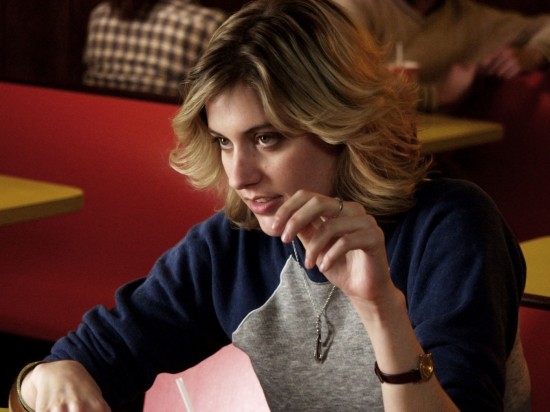 Speaking of Loverboy, one of the funnest and strangest details in the film involves pizza. I got spooky vibes when I connected the pizza in the early scene in the pizza parlor (above with Gerwig's Megan) with the pizza later on...Ti West: [laughs] It was certainly foreshadowing to that, commenting on something to come later, with the pizza being portrayed as gross. And Greta, certainly, the way I directed her in that scene was to be gross when she eats. [laughs] And it was, you know, forshadowing that pizza would play a part later in the film.And there's even a shot of a pizza chef statue that I found hilarious because it's so what-the-fuck ominous...Ti West: Yeah. [laughs] That statue was just there, and like you said, it felt like a good out-point. And it goes back to me showing you a lot of stuff in this pizza place and it's there for a reason. It's there as a reminder. But, yeah, that statue was just in that pizza place, so I was like, "How could I not shoot that?"And to me, I love that it's there as a loose end, because, you know, in the '80s so many horror films had these ridiculous loose ends, and plot contrivances. It seemed like so many of those directors were so coked out of their minds that they forgot to develop them. [laughs]Ti West: Yeah. [laughs] I'm also a really big fan of that and enigmatic stuff in movies; these details that come and go and you never get the full story with them, but they resonate in your head afterward. So, after you're done watching the film, you go, "What was the deal with that thing?" and it encourages you to think about the film rather than just experiencing it on a surface level.Yeah. [laughs] I even went so far with it as to draw parallels between pentragrams and pizzas in terms of the circle and in terms of a dish-like scenario that happens near the end...Ti West: That's...interesting. I hadn't considered that, I didn't make that connection. But that's...interesting.
Speaking of Loverboy, one of the funnest and strangest details in the film involves pizza. I got spooky vibes when I connected the pizza in the early scene in the pizza parlor (above with Gerwig's Megan) with the pizza later on...Ti West: [laughs] It was certainly foreshadowing to that, commenting on something to come later, with the pizza being portrayed as gross. And Greta, certainly, the way I directed her in that scene was to be gross when she eats. [laughs] And it was, you know, forshadowing that pizza would play a part later in the film.And there's even a shot of a pizza chef statue that I found hilarious because it's so what-the-fuck ominous...Ti West: Yeah. [laughs] That statue was just there, and like you said, it felt like a good out-point. And it goes back to me showing you a lot of stuff in this pizza place and it's there for a reason. It's there as a reminder. But, yeah, that statue was just in that pizza place, so I was like, "How could I not shoot that?"And to me, I love that it's there as a loose end, because, you know, in the '80s so many horror films had these ridiculous loose ends, and plot contrivances. It seemed like so many of those directors were so coked out of their minds that they forgot to develop them. [laughs]Ti West: Yeah. [laughs] I'm also a really big fan of that and enigmatic stuff in movies; these details that come and go and you never get the full story with them, but they resonate in your head afterward. So, after you're done watching the film, you go, "What was the deal with that thing?" and it encourages you to think about the film rather than just experiencing it on a surface level.Yeah. [laughs] I even went so far with it as to draw parallels between pentragrams and pizzas in terms of the circle and in terms of a dish-like scenario that happens near the end...Ti West: That's...interesting. I hadn't considered that, I didn't make that connection. But that's...interesting.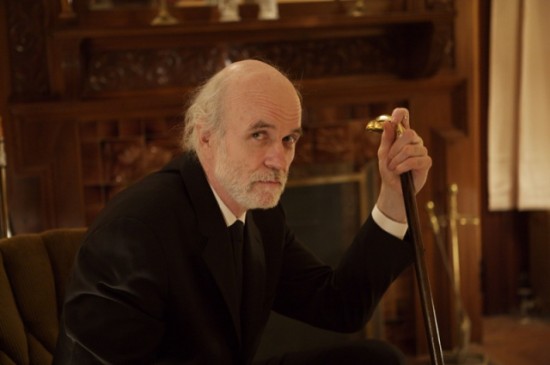 You are probably over talking about this, but you're becoming associated with scenes that involve walking in your films. [laughs] You're becoming associated with walking not unlike Tarantino is with feet...Ti West: This might be the case of writers looking too far into things. In the case of (2007's) Trigger Man, that movie is about hunting, and a big part of hunting is walking around and being bored. So, that's where that comes from. In terms of this film, I mean I think college-wise, most people walk a lot in general and walk all over campus. But once we get to the house, it's par for the course. I definitely do not have a fetish for walking or something like that. [laughs][laughs] So, it sounds like you want to distance yourself from that journalistic observation...Ti West: [laughs] I mean, by all means, run with it if you feel necessary. But I wouldn't say it's accurate unless it's some deep subconscious obsession I have with walking from point A to be point B.
You are probably over talking about this, but you're becoming associated with scenes that involve walking in your films. [laughs] You're becoming associated with walking not unlike Tarantino is with feet...Ti West: This might be the case of writers looking too far into things. In the case of (2007's) Trigger Man, that movie is about hunting, and a big part of hunting is walking around and being bored. So, that's where that comes from. In terms of this film, I mean I think college-wise, most people walk a lot in general and walk all over campus. But once we get to the house, it's par for the course. I definitely do not have a fetish for walking or something like that. [laughs][laughs] So, it sounds like you want to distance yourself from that journalistic observation...Ti West: [laughs] I mean, by all means, run with it if you feel necessary. But I wouldn't say it's accurate unless it's some deep subconscious obsession I have with walking from point A to be point B.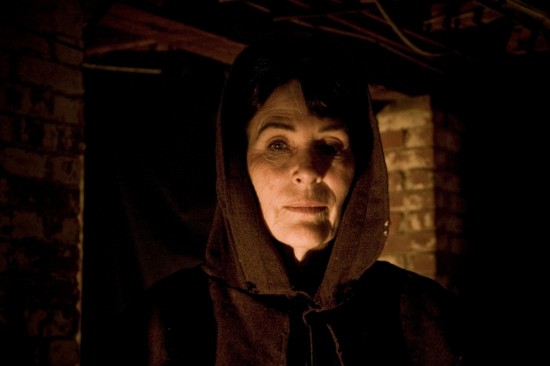 Within the current state of horror, you've contributed a classy film. Was it a conscious decision not to have nudity in the film and sex; well, there is sex, with Sam's roommate, Heather (Heather Robb), who is kind of a...slut. You've mentioned that when you were making Cabin Fever 2, you included a lot of blow jobs, breasts, and stuff. Why not here?Ti West: It just wasn't what this movie was about, you know what I mean? There's sexuality in this film, but it's more of a repressed sexuality than anything else. I think Mary Woronov's character (above) makes Samantha really uncomfortable with some sexual tension, and that's really great, but for the most part I wanted Samantha to have this asexual sort of vibe, where it's not...she has no love interest in the movie and I had no interest in pursuing that. So, it's a case-by-case basis on that.Let's get real for a second. Have you ever attended a Satanic seance or messed with a Ouija board, even for research purposes or while pursuing a hobby?Ti West: I've messed with Ouija boards. And I've snuck into the basement of an abandoned mental hospital that's supposed to be haunted, that kind of stuff. That was just in my childhood. I've always had this obsession with Satanic Panic and I like the idea of the mysticism, where, like, religion and horror meet. I think there is something very spooky about that.What role has Larry Fessenden played in your films? His company Glass Eye Pix is behind all of them, complete with really great bumpers on each film. Would you describe it as a mentor relationship?Ti West: I wouldn't say that it's directly mentorish, but Larry is definitely the greatest guy ever and probably the most important in my filmmaking life. I met him, when I was 20ish, because I knew Kelly Reichardt (Old Joy, Wendy and Lucy), and he had produced her film, River of Grass, and she was like, "Have you ever watched this movie Habit?" And I had seen it, and she was like, "You should meet that guy." And we just really got along.And after Larry had seen my short films, he asked, "Why don't you make a feature?" and I was, like, "I don't know." And he asked if it was because of money, and he said, "If I give you a little bit of money, could you do it all on your own?" So, that's what happened with The Roost (2006): he gave me a little money and we made the movie and it kind of did well. And then I did Trigger Man with him, and then I went off and did Cabin Fever 2, which turned into a really shitty situation. And then after that, there was the opportunity to "return back home," so to say, to make The House of the Devil.
Within the current state of horror, you've contributed a classy film. Was it a conscious decision not to have nudity in the film and sex; well, there is sex, with Sam's roommate, Heather (Heather Robb), who is kind of a...slut. You've mentioned that when you were making Cabin Fever 2, you included a lot of blow jobs, breasts, and stuff. Why not here?Ti West: It just wasn't what this movie was about, you know what I mean? There's sexuality in this film, but it's more of a repressed sexuality than anything else. I think Mary Woronov's character (above) makes Samantha really uncomfortable with some sexual tension, and that's really great, but for the most part I wanted Samantha to have this asexual sort of vibe, where it's not...she has no love interest in the movie and I had no interest in pursuing that. So, it's a case-by-case basis on that.Let's get real for a second. Have you ever attended a Satanic seance or messed with a Ouija board, even for research purposes or while pursuing a hobby?Ti West: I've messed with Ouija boards. And I've snuck into the basement of an abandoned mental hospital that's supposed to be haunted, that kind of stuff. That was just in my childhood. I've always had this obsession with Satanic Panic and I like the idea of the mysticism, where, like, religion and horror meet. I think there is something very spooky about that.What role has Larry Fessenden played in your films? His company Glass Eye Pix is behind all of them, complete with really great bumpers on each film. Would you describe it as a mentor relationship?Ti West: I wouldn't say that it's directly mentorish, but Larry is definitely the greatest guy ever and probably the most important in my filmmaking life. I met him, when I was 20ish, because I knew Kelly Reichardt (Old Joy, Wendy and Lucy), and he had produced her film, River of Grass, and she was like, "Have you ever watched this movie Habit?" And I had seen it, and she was like, "You should meet that guy." And we just really got along.And after Larry had seen my short films, he asked, "Why don't you make a feature?" and I was, like, "I don't know." And he asked if it was because of money, and he said, "If I give you a little bit of money, could you do it all on your own?" So, that's what happened with The Roost (2006): he gave me a little money and we made the movie and it kind of did well. And then I did Trigger Man with him, and then I went off and did Cabin Fever 2, which turned into a really shitty situation. And then after that, there was the opportunity to "return back home," so to say, to make The House of the Devil.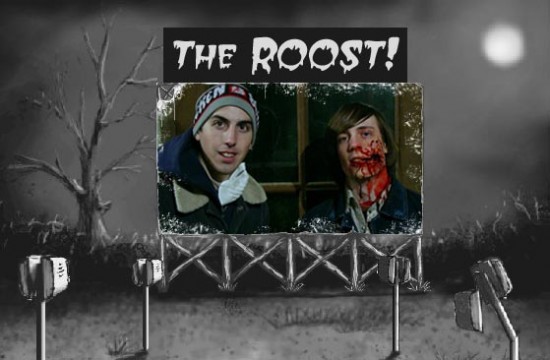 I know that your experience on Cabin Fever 2: Spring Fever was "shitty," but I'm not sure I originally understood the appeal to you in following-up a horror film by Eli Roth. Obviously, Roth is a big name in horror, but you guys have very different styles and outlooks on the genre...Ti West: We have incredibly different styles. I mean, we like the same stuff but we make very different movies. But the appeal was that I could do whatever I wanted with it; I mean, [Lions Gate] let me do everything I wanted with it, and then at one point, it just completely backfired. So, it was like, the first four months of making Cabin Fever was one of the best filmmaking experiences I've ever had in my life. And I was super-psyched on the movie; but then it went from [Lions Gate saying], "You can do anything you want, we're supportive of that, and we agree with everything you want"...to: "Actually, we don't want that anymore." So, that's when things went south.Was the main issue with the studio that you had made a horror-comedy that was inspired by films like Rock 'n' Roll High School? I mean, I know that I had no interest in seeing a direct-to-DVD sequel to Roth's film, but hearing about your take on it, even before I saw [The House of the Devil], it was least on my radar...Ti West: It was the kind of thing where Cabin Fever 2 was going to be the weirdest follow-up ever, to the point where [people would say], "This is not what Cabin Fever 2 should have been!" And that is actually what [Lions Gate] were excited about, and what I was excited about. But then, towards the end of the editing process, they went, "Wait, this isn't what the film should be like, so we want to try to make it like the first one." And then the rifts started...Where does that film stand now?Ti West: Uh, yeah, it stands in the Alan Smithee category.
I know that your experience on Cabin Fever 2: Spring Fever was "shitty," but I'm not sure I originally understood the appeal to you in following-up a horror film by Eli Roth. Obviously, Roth is a big name in horror, but you guys have very different styles and outlooks on the genre...Ti West: We have incredibly different styles. I mean, we like the same stuff but we make very different movies. But the appeal was that I could do whatever I wanted with it; I mean, [Lions Gate] let me do everything I wanted with it, and then at one point, it just completely backfired. So, it was like, the first four months of making Cabin Fever was one of the best filmmaking experiences I've ever had in my life. And I was super-psyched on the movie; but then it went from [Lions Gate saying], "You can do anything you want, we're supportive of that, and we agree with everything you want"...to: "Actually, we don't want that anymore." So, that's when things went south.Was the main issue with the studio that you had made a horror-comedy that was inspired by films like Rock 'n' Roll High School? I mean, I know that I had no interest in seeing a direct-to-DVD sequel to Roth's film, but hearing about your take on it, even before I saw [The House of the Devil], it was least on my radar...Ti West: It was the kind of thing where Cabin Fever 2 was going to be the weirdest follow-up ever, to the point where [people would say], "This is not what Cabin Fever 2 should have been!" And that is actually what [Lions Gate] were excited about, and what I was excited about. But then, towards the end of the editing process, they went, "Wait, this isn't what the film should be like, so we want to try to make it like the first one." And then the rifts started...Where does that film stand now?Ti West: Uh, yeah, it stands in the Alan Smithee category.
(Kookball side note: Before the following interview occurred, I did a sound check on my recording equipment by saying, "House of the Devil, October 2009, check check check, 666." All was fine. Minutes into the interview, the recording process went awry, as the recorder stopped taping on its own accord several times. Upon playback, not only does the first part of the recorded conversation conjure a heavy metal album played backwards, but bizarre, Ed Wood-like theremin effects surface near the end. When I returned to Radio Shack for a refund, everyone inside the store was dead.)
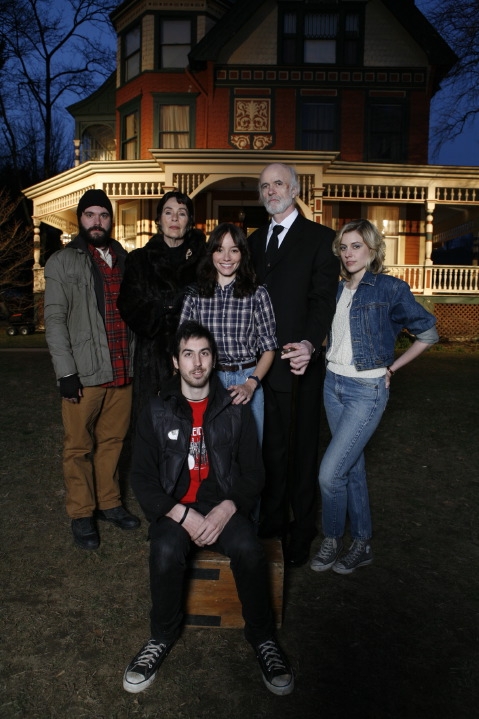 Hunter Stephenson can be reached at h.attila/gmail and on twitter. For Hunter's 9.666/10 review of The House of the Devil, here.
Hunter Stephenson can be reached at h.attila/gmail and on twitter. For Hunter's 9.666/10 review of The House of the Devil, here.
